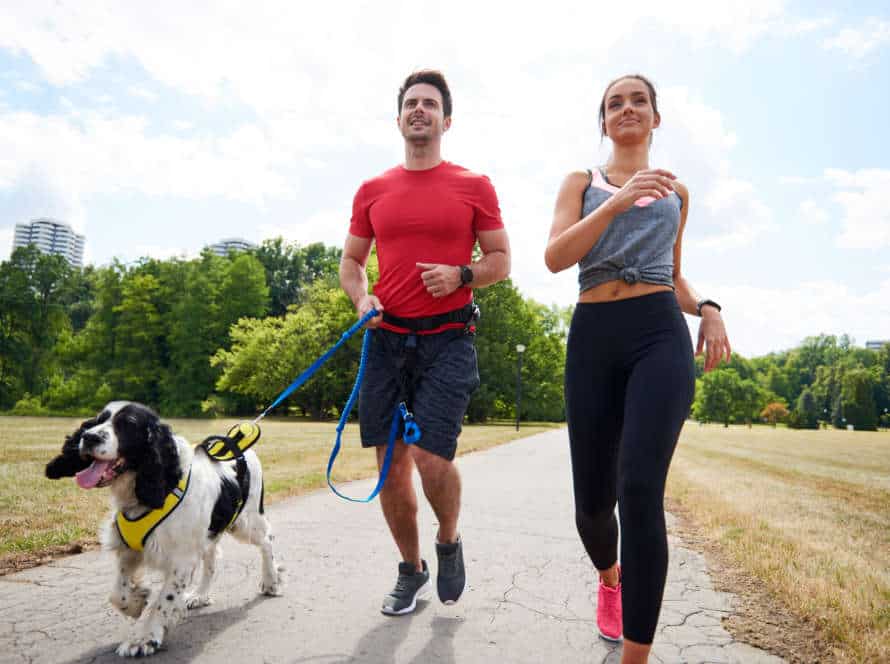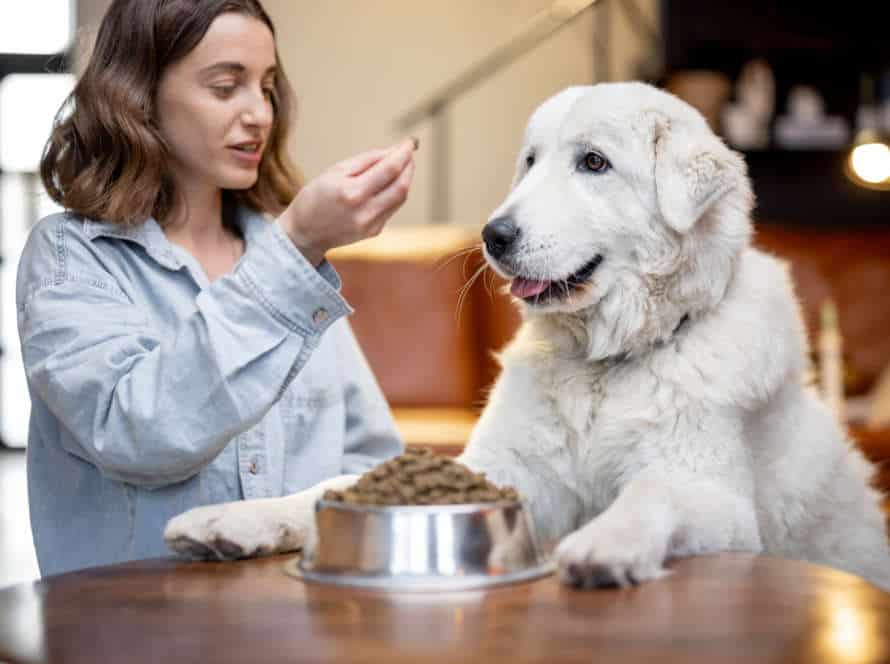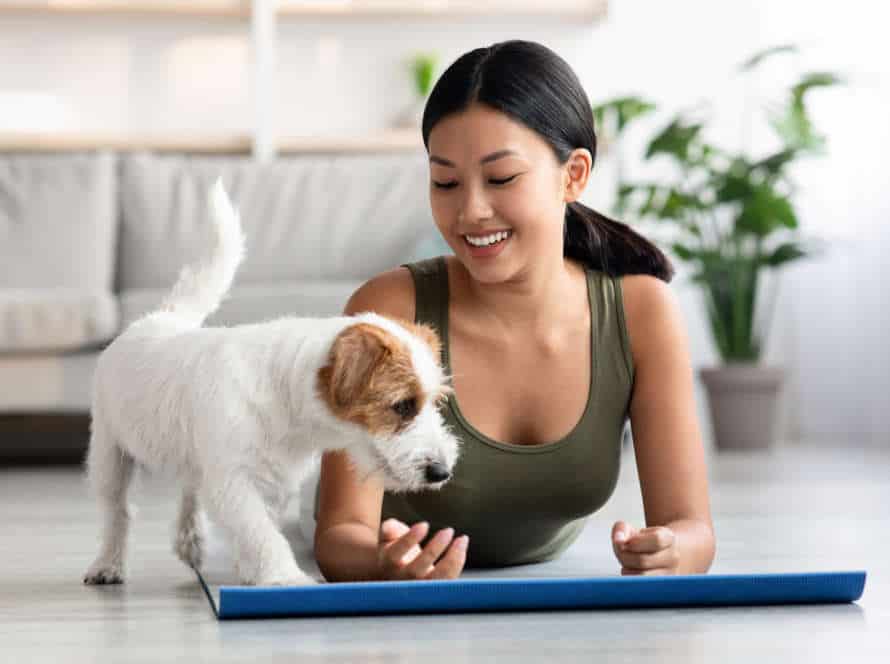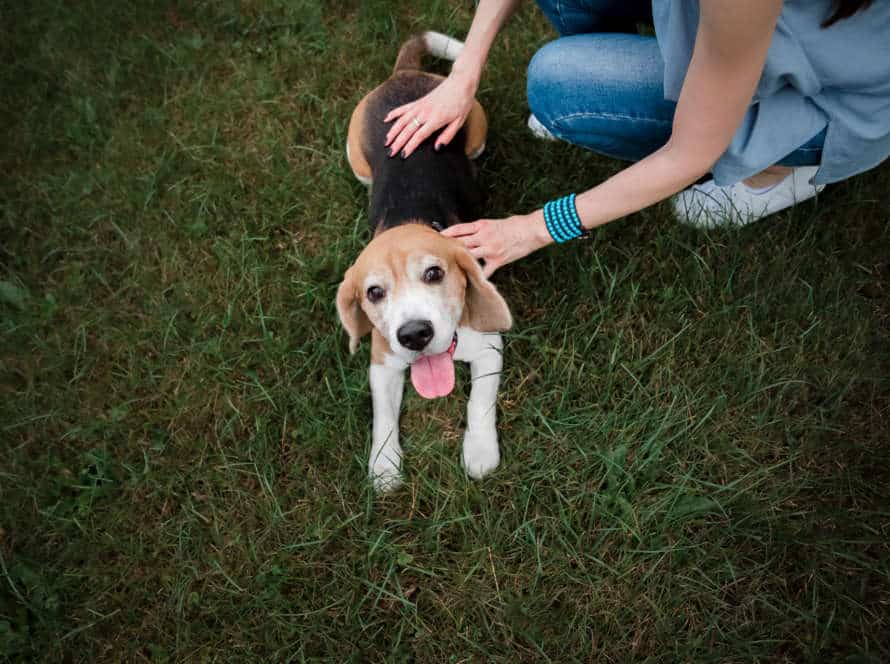Why Exercise is Essential for Your Dog’s Health
It’s so important for your pup’s physical and mental health to get regular exercise. Here’s why:
- It helps maintain a healthy weight. Taking short walks, running, and playing fetch are great ways to keep the extra pounds off.
- It offers mental stimulation. Sniffing walks, puzzle toys, and obedience classes keep them from getting bored, stressed, or anxious.
- It reduces behaviour problems. Dogs with too much energy can act out by chewing, barking, digging, or being aggressive. Giving them exercise helps. Plus, it helps with training and obedience.
- It strengthens your bond. Going to the dog park or playing fetch together is a fun way to get closer.
But, every dog is different. Talk to your vet first before starting a new exercise routine.
The Benefits of Exercise for Dogs
Exercising with your pooch can be advantageous for both of you. It can add years to their life and make them physically and mentally fit. It can also help them stay strong, healthy, and content. Furthermore, it can benefit your relationship with your canine and even diminish stress. Let’s look into the numerous advantages that exercise can bring your pup!
Physical Health Benefits of Exercise
Exercise has physical advantages for both humans and their four-legged friends. It’s not just a fun activity for dogs but also crucial for their general health and welfare. Here are some of the benefits:
- Weight management: Exercise helps dogs stay at a healthy weight, preventing obesity-related conditions such as diabetes, heart disease, and joint issues.
- Cardiovascular health: Working out often strengthens a dog’s heart, lungs, and circulation, promoting better cardiovascular health.
- Muscle and bone strength: Exercise helps build stronger muscles and bones, minimizing the risk of injury or age-associated issues like arthritis.
- Digestive system: Exercise energizes a dog’s digestive system, promoting regularity, and avoiding constipation.
- Mental wellness: Exercise is a great way to reduce stress, anxiety, and boredom, keeping your pet mentally healthy and content.
Mental Health Benefits of Exercise
Exercise is essential for both dogs and humans! Its many mental benefits are undeniable. Here are a few:
- Reduces stress and anxiety. Exercise boosts endorphins in the brain, lifting moods and calming nerves.
- Enhances cognitive functions. Physical activity can improve memory, attention, and concentration.
- Improves sleep quality. Exercise regulates the sleep-wake cycle and reduces stress.
- Boosts self-esteem. Regular exercise increases confidence and self-image.
- Helps combat depression. Exercise releases endorphins, boosts self-image and provides a sense of accomplishment.
Remember: to get the most out of exercise, find something you enjoy doing. This makes it easier to stay with it long-term.
Socialization Benefits of Exercise
Exercise is vital for a pup’s physical and emotional wellbeing. Socialization is one of the primary advantages that come with consistent exercise for dogs. Here are some of the socialization benefits of exercise for dogs:
- Better behavior around other dogs – With regular exercise, dogs become more relaxed and confident when with their pals, reducing aggressive behavior.
- More interaction with humans – During outdoor activities, dogs meet different people, helping them feel at ease around people. This also helps them adjust to new people and situations.
- Decreased anxiety – Exercise assists dogs in decreasing anxiety by releasing endorphins that lift mood, minimize stress, and foster confidence.
- Improved obedience – Dogs that exercise regularly are more responsive to commands and are more focused.
Regular exercise helps your pup develop social skills, reduces its risk of depression, and enhances its mental and physical state.
How Much Exercise Does Your Dog Need?
Exercise is a must for your pooch’s health! It builds muscles and joints, plus keeps the weight healthy. Not to mention, it stimulates their minds, reduces stress and creates a strong bond with you. So, how much exercise should your pup get? Let’s find out!
Factors Affecting Your Dog’s Exercise Needs
Your pup’s exercise needs depend on various factors, such as breed, age, overall health, and personality. Higher-energy breeds need more daily exercise, while low-energy breeds need less. Puppies have shorter exercise needs than grown-up dogs as they are still developing. Older pooches may need less exercise due to age-related health issues. Plus, illnesses like arthritis and breathing troubles can limit how much and how intense the exercise your dog can do.
Exercise is crucial for the pooch’s health. It helps with weight, prevents destructive behavior, increases joint flexibility, and keeps the pup mentally stimulated. It’s essential to understand your pup’s individual needs and create an exercise routine that keeps them fit and happy.
Guidelines for Exercise Duration and Intensity
Knowing the right exercise length and intensity is key to keeping your pup happy and healthy. It depends on the breed, age and their health needs. Generally, give them at least 30 minutes a day of activity. Higher intensity for younger, more active breeds. Here’s some guidelines:
- High energy breeds like Retrievers, Huskies and Setters need 60 mins of intense activities each day. Such as running, hiking, and advanced obedience training.
- Medium energy breeds like Beagles, Bulldogs, and Cocker Spaniels need 45 mins of moderate intensity activities daily. Like swimming, walking, and playing fetch.
- Low-energy breeds like Basset Hounds, Pugs, and Shih Tzus need 30 mins of low-intensity activities daily. Such as slow walks, light playtime, and short hikes.
Remember to consider your dog’s age, breed, weight and overall health when deciding exercise intensity and duration.
Tailoring Exercise to Your Dog’s Age and Breed
Tailoring exercise to fit your pup’s age and breed is key for their overall health. Different ages and breeds have varying needs and capabilities.
Puppies: Short, low-impact activities help them grow strong. Walks, playtime with other doggos, and fetch games are ideal.
Adults: Exercise amounts and types differ. Some require high-intensity activities like running and swimming. Others prefer light exercise like stretching and yoga.
Senior dogs: They’re less active, so lower-impact activities like slow walks or water therapy help keep them moving and reduce joint problems.
Always check with your vet for the best exercise routine for your pup’s age, breed, and health.
Types of Exercise for Your Dog
Exercise is key for your pup’s health and happiness. It helps in multiple ways, physically and mentally. To find the exercise best for your dog, it is important to understand the different types. This article will tell you all about the kinds of exercise suited to your pet’s needs.
Walking and Hiking
Walking and hiking are exercises great for dog owners and their pups. Both provide many benefits for physical and mental health. Walking is the simplest exercise for any pup – just 30 minutes daily can help improve cardio, digestion, and joint flexibility! Further, it can help reduce anxiety, stress, and depression in dogs with behavioural issues. This is because physical activity releases endorphins that can boost your dog’s mood.
Hiking is a more intense workout, especially for working or herding breeds like Border Collies or Australian Shepherds. It is a great way for dogs to explore nature, get fresh air and natural light, and strengthen muscles and bones.
Before beginning any exercise routine, consult with your vet. They can determine the amount and intensity of exercise needed based on your pup’s age, breed, health status, and weight.
Running and Jogging
Running and jogging are two great ways to exercise your pup. Running helps your pup expend energy quickly and build strength and endurance. Jogging is a gentler option for dogs with orthopedic issues or those just starting out. Both can help improve cardiovascular health and promote weight loss. Plus, they can reduce the risk of behavioral issues and give mental stimulation.
Start slow and gradually increase duration. Consider age, breed, and overall health before beginning. Pro tip- Make sure your pup is hydrated before, during, and after exercise. Bring a collapsible water bowl and water for you both on runs and jogs.
Swimming
Swimming is a great, low-impact exercise for dogs. It’s beneficial for strength, endurance and flexibility. Plus, it’s gentle on their joints!
Benefits of Swimming:
- Full body workout: Engages all the muscles.
- Low impact: Safe for dogs with injuries or arthritis.
- Mental stimulation: Keeps them active and develops problem-solving skills.
- Perfect for hot weather: Helps prevent heatstroke and other illnesses.
Remember to supervise your dog and make sure they are confident swimmers before letting them in the water.
Agility Training and Obstacle Courses
Agility training and obstacle courses are awesome for dogs! It has lots of physical and mental benefits. Agility training has jumps, tunnels, poles, and other obstacles to go through in a set time. Not only does it help burn off energy, but it strengthens muscles, joints, vision, balance, and cognition. It even boosts confidence and reduces anxiety.
Obstacle courses challenge problem-solving skills and mental acuity. Plus, they have different terrains like inclines, stairs, tunnels, and hurdles. This keeps your dog fit and healthy in the long run. Regular agility training and obstacle courses keep your pup happy and healthy!
Exercise Safety for Your Dog
Exercising your pup is essential for keeping them healthy. It builds strength and muscle, and avoids bad behaviour. But, there are risks if you don’t take the right steps. Safety is key when it comes to exercise for your dog. So, make sure you take precautions to let them enjoy their daily workout safely.
Signs of Overexertion
Overexertion is a common problem in dogs during exercise. Look out for signs like heavy panting, wheezing, coughing, lethargy, weakness, increased heart rate or breathing difficulty, vomiting, diarrhea, muscle tremors, or seizures. If you spot any of these, stop the exercise right away and give your pooch water and a cool, comfy resting place. Give them small amounts of water at one time to avoid vomiting. If there’s no improvement, contact the vet.
Pro Tip: Start with shorter exercises and gradually increase intensity and duration. Monitor exhaustion signs and adjust your pup’s routine. Always prioritize safety and health of your canine companion.
Avoiding Common Exercise-Related Injuries
Exercising is essential for your pup’s physical and mental well-being. But, to keep them safe, here are some tips:
- Warm-up: Get their muscles loose, like you would yours – with a little walking or playtime!
- Equipment: Make sure you have the right leash, collar, or harness for their size and strength.
- Surface: Choose grass or rubber tracks – not pavements! – to prevent paw and joint injuries.
- Start Slow: Don’t rush their exercise – gradually increase the intensity and duration over time.
- Rest & Hydrate: Provide plenty of rest and water to hydrate and avoid dehydration.
By following these precautions, you’ll guarantee your pup’s exercise routine is both safe and fun!
Proper Hydration and Nutrition for Active Dogs
Humans and dogs both need hydration and nutrition for being healthy. Here are some tips to keep your pup fit and happy:
- Hydration: Make sure your pup has access to clean water, especially when exercising. Take a water bottle and bowl for them on long walks or hikes.
- Nutrition: Feed your pooch a balanced, high-quality diet that matches their age, size, and activity level. Check with your vet for specialized dietary advice.
- Treats: Treats can be a great way to reward good behavior during exercise or training. Pick treats that are low in calories, high in protein, and without artificial flavors or preservatives.
Pro tip: Don’t feed your pup before or after exercise to avoid stomach problems. Wait an hour before or after exercise before feeding them.
Incorporating More Exercise into Your Dog’s Life
Exercise is key for your pup’s wellbeing – physical and mental. It keeps ’em active, healthy, reduces stress and decreases anxiety. Plus, it helps build strong muscles and a strong bond with you!
Let’s look at why it’s important and how to get more exercise into your doggo’s life.
Scheduling Daily Exercise Routines
Create daily exercise routines for your pup! This is a crucial part of looking after their well-being. To include more exercise in their life, make a couple of simple adjustments to your routine.
Here’re some tips:
- Set a goal each day. How much exercise they need depends on breed and age.
- Follow a pattern. Pick a set time and activity to do every day.
- Include games and brain-stimulating activities like fetch or hide-and-seek.
- Outdoor fun! Go for walks, hikes, or to the dog park.
Pro Tip: Ask your vet for advice on the best exercise plan suited to your pet’s health and physical needs.
Making Exercise a Fun and Engaging Experience
Exercising with your pup can be an enjoyable time that helps boost both their physical and mental health. Here are some tips to add more exercise into your doggo’s life:
- Take your pup for walks or jogs in various places, like parks, hiking trails, or beaches, to make it fun.
- Play games like fetch, tug-of-war, or hide-and-seek with your pup.
- Train your pup new tricks and obedience commands, which benefits them mentally.
- Try doggo sports such as agility or flyball, which can be a fun and challenging way to exercise them.
- Remember, regular exercise is key for their wellbeing, so make it part of your day-to-day.
Pro tip: Use interactive toys, like puzzle toys or automatic ball launchers, to make them move even when you can’t be active with them.
Using Dog-Specific Fitness Devices and Tools
Dog-specific fitness devices and tools can help you give your pup more exercise! Popular ones include:
- Treadmills designed just for dogs. Perfect for burning energy and staying healthy!
- Agility equipment like jumps, weave poles, and tunnels. Keeps them active and sharp.
- Fetch toys like frisbees and balls. So much fun and great for endurance.
- Walking and running harnesses. Get your pup out and about with you, safely and comfy.
Exercise isn’t just great for physical health. It also gives mental stimulation and reduces stress. So get some dog fitness gear and let your pup have a blast!
Frequently Asked Questions
Q: Why do dogs need exercise?
A: Dogs need exercise to maintain their physical and mental health. Regular exercise can help prevent obesity, promote proper digestion, provide mental stimulation, and promote better behavior.
Q: How much exercise does my dog need?
A: The amount of exercise your dog needs depends on the breed, age, and overall health. A general guideline is to aim for at least 30 minutes of physical activity per day for most dogs, but some breeds may require more.
Q: What types of exercise are best for dogs?
A: The best types of exercise for dogs are those that are safe and enjoyable for them. This can include walking, running, swimming, playing fetch, and agility training. Consult with your veterinarian to determine what exercises are appropriate for your dog.
Q: Can lack of exercise cause health problems in dogs?
A: Yes, lack of exercise can lead to a variety of health problems including obesity, joint problems, respiratory issues, and behavioral problems.
Q: What are some signs that my dog is not getting enough exercise?
A: Signs that your dog may not be getting enough exercise include weight gain, destructive behavior, excessive barking, and restlessness.
Q: How can I incorporate exercise into my dog’s daily routine?
A: You can incorporate exercise into your dog’s daily routine by taking them for regular walks or runs, playing games like fetch or tug-of-war, and engaging in training activities like agility or obedience training.







